Square Escape is a game where the player is a small box trying to escape a series of rooms to reach the outside world. The character has simple actions: moving in all four directions, picking up keys, evading static and moving barriers, and exiting through doors in a given amount of time.
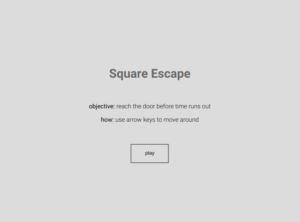
There are five levels that the player needs to overcome to win the game. Each level increases the difficulty of the game: the time changes, the amount of barriers increases, the movement and direction of the barriers varies, the distance between the square and the door grows, and the keys are placed in different positions. The player’s objective will be to reach the door in time, else he will have to restart the level.
Square Escape relates to the escape theme because the main objective of the player is to exit each one of the five doors to win the game while evading the blocks that are getting in the way. The anxiety of not being able to reach the door in time and the fear of being crushed by the barriers are feelings that I relate with escape. When trying to implement the concept into the game, I designed the levels in a way that were constantly evoking those type of emotions.
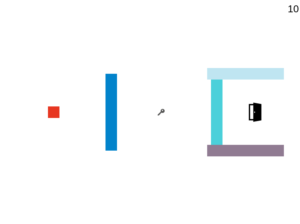
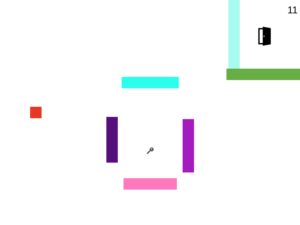
There is one player, alone, in a spacious environment filled with aggressive obstacles getting in its way of freedom. There is just one exit in each level that the player must reach every time. There is one a key and one barrier that moves to unlock the door. The player’s only available action is to move around using the arrow keys, there are no powers, no strength, no stamina, and no magic. The player must endure the collisions with the barriers to reach the final objective.
I had initially envisioned a very complex game. One that included scoring, bonus points, enemies, and a circle instead of a square as the character. This idea was beyond what I could’ve achieved in just one week of work. After receiving feedback from my professor and classmates, I knew I needed to simplify the game and focus mainly on the escape theme. Thus, I decided to remove extra components and focus mainly on designing the levels, using a square as the character, having moving barriers, and setting one key to open one door. I believe simplifying the game was the best decision, as it allowed me to focus more on the assigned concept and actually succeed in designing a playable 2D platform game.
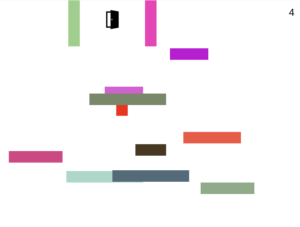
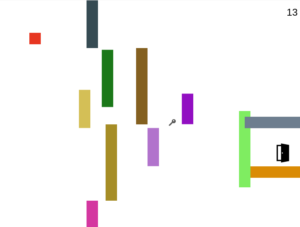
The feedback I received from play-testing was incredibly very helpful. I made ten students play the game and observed their reactions. During Level 1 and Level 2, most students explored the game. They were figuring out how the timer worked, how to move around the screen, and how to reach the door. During Level 3 and Level 4, most of them had gotten the hang of how the game worked and they started using their skills to exit the doors. I was able to see a little of frustration, but a lot of engagement. Students were restarting the level up to seven times before even thinking of giving up. Level 5 was beat by very few people, only the ones that were most engaged did not stop playing. After watching all student interactions with the game, I asked for comments and/or suggestions. I took them all into consideration and decided to make the following changes:
- Start the timer only when the player begins moving
- Make the difficulty gap between level 2 and level 3 smaller
- Modify level 1 to match the later levels
- Increase the number of seconds given to the player as the levels get harder and harder
- Make the square’s speed higher
- Switch up the directions and rotations in which the barriers move
- Make the last level beatable (it was impossible to win)

All these changes helped me transform the game into what it is currently. However, I still think there are some other things that can be improved (changes I wasn’t able to change due to time constraints) to make the game better overall. Some of these include: giving the barriers better placements, designing more levels, slowly building up the difficulty, fixing the glitches where the square goes through the barriers, and including multiple keys/doors.
The Routledge Companion to Video Game Studies focuses on three artifact categories of video games: material, software, and cultural. The software aspect focuses on “the role of procedural rules in the meaning-making process” and the cultural aspect focuses on the “idea that games carry embedded meanings that are shaped when used.” I believe Square Escape could be considered to be a software and a cultural artifact. First, I went through a very detailed process when deciding the rules and mechanics my game would have in order to represent accurately the escape theme. In addition, when people played the game they commented on how trapped they felt in between the obstacles I had set up and had been frustrated when they couldn’t reach the next level door. Square Escape is a human-made digital artifact where I always had to think first about the meaning and context before putting something on the screen.
Link to game: air258.nyuad.im/p5-play-game/main.html